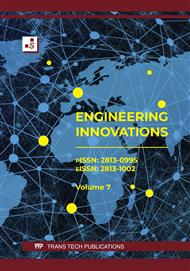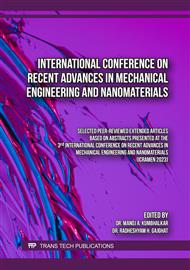[1]
Muthiah, G. Karthick, M. Kalimuthu, K. Muthusamy, C. Kanagaraj, Modal Analysis of Chassis Using CAE Prediction, International Journal of Science Technology & Engineering. 7(11) (2021) 40-43. https://ijste.org/Article.php?manuscript=IJSTEV7I11013
Google Scholar
[2]
Vishwakarma, A. Prajapati, S. Mahadeokar, A. Vishwakarma, Design & Analysis of Truck Chassis Frame using CAE Tools, International Research Journal of Modernization in Engineering Technology and Science. 3(9) (2021) 756-761. https://www.irjmets.com/uploadedfiles/paper/volume_3/issue_9_september_2021/16172/final/fin_irjmets1631798148.pdf
DOI: 10.56726/irjmets35193
Google Scholar
[3]
M.V. Chugunov, I.N. Polunina, A.G. Divin, et al. Integrated Mobile Robotic Platform Model, Engineering Technologies and Systems. 31(4) (2021) 609-627
DOI: 10.15507/2658-4123.031.202104.609-627
Google Scholar
[4]
S. Jawadekar, P. Balgaonkar, CAE simulations for an Optimal & Cost-effective Automotive Chassis Design, https://www.itcinfotech.com/wp-content/uploads/2017/06/CAE-Simulations-For-An-Optimal-Cost-Effective-Automotive-Chassis-Design.pdf
Google Scholar
[5]
N. Demir, H.S. Sucuoglu, I. Bogrekci, P. Demircioglu, Structural & Dynamic Analyses and Simulation of Mobile Transportation Robot, Int. J. of 3D Printing Tech. Dig. Ind., 5(3) (2021) 587- 595
DOI: 10.46519/ij3dptdi.949803
Google Scholar
[6]
Zhou Jian, Yang ZhiMin, Chen Song Lin, Analysis of the harvesting robot arm modal based on CAE, Journal of Chemical and Pharmaceutical Research. 6(11) (2014) 669-673. https://www.jocpr.com/articles/analysis-of-the-harvesting-robot-arm-modal-based-on-cae.pdf
Google Scholar
[7]
J. Ze, C. Bo, Z. Ju, Y. Li, Y. Xu, Y. Zhao, Design and analysis of a wall-climbing robot for water wall inspection of thermal power plants, Journal of Field Robotics, (2023), https://doi.org/
DOI: 10.1002/rob.22171
Google Scholar
[8]
H.S. Lee, S.L. Chang, Development of a CAD/CAE/CAM system for a robot manipulator, Journal of Materials Processing Technology. 140 (2003) 100–104. https://doi.org/
DOI: 10.1016/S0924-0136(03)00695-2
Google Scholar
[9]
H. Jiang, B. Yu, X. Qi, C. Pan and J. Yang, Structural Design and Simulation Analysis of Quadruped Tree Climbing Robot, Journal of Physics: Conference Series, (2023) 2437-012116. DOI: 0.1088/1742-6596/2437/1/012116
DOI: 10.1088/1742-6596/2437/1/012116
Google Scholar
[10]
A.S. Agbadua, C.C. Obinwa, E.A. Agbomabinu, S.O. Sheidu and M.I. Joseph, Verification of Computer Aided Engineering (CAE) in Optimization of Chassis for Tricycle, International Journal of Innovative Research in Advanced Engineering, 6(3) (2016) 98-102
Google Scholar
[11]
S. Kakria, and D. Singh, CAE Analysis, Optimization and Fabrication of Formula SAE Vehicle Structure, SAE Technical Paper. 2015-01-0072, (2015).
DOI: 10.4271/2015-01-0072
Google Scholar
[12]
M.H. Korayem, N. Shiehbeiki and T. Khanali, Design, manufacturing, and experimental tests of a prismatic robot for assembly line, The International Journal of Advanced Manufacturing Technology, 29 (2006) 379–388
DOI: 10.1007/s00170-005-2524-1
Google Scholar
[13]
W. Hai-fei, J. Kun-kun and G. Zi-peng, Random vibration analysis for the chassis frame of hydraulic truck based on ANSYS, Journal of Chemical and Pharmaceutical Research, 6(3) (2014) 849-852. https://www.jocpr.com/articles/random-vibration-analysis-for-the-chassis-frame-of-hydraulic-truck-based-on-ansys.pdf
DOI: 10.1109/cinc.2010.5643716
Google Scholar
[14]
J.J. Gumasing, Overall Improvement for the Design of Motorized Tricycles in the Philippines - An Ergonomic Study, Proceedings of the International Conference on Industrial Engineering and Operations Management, Bali, Indonesia. (2014) 1509-1517.
Google Scholar
[15]
Y.S. Rajput, V. Sharma, S. Sharma & G. Saxena, A Vibration Analysis of Vehicle Frame, International Journal of Engineering Research and Applications, 3(2) (2013) 348-350.
Google Scholar
[16]
K.Y. Patil and E.R. Deore, Stress Analysis of Ladder Chassis with Various Cross Sections, International Journal of Mechanical and Civil Engineering, 10(4) (2015) 111-116.
Google Scholar



